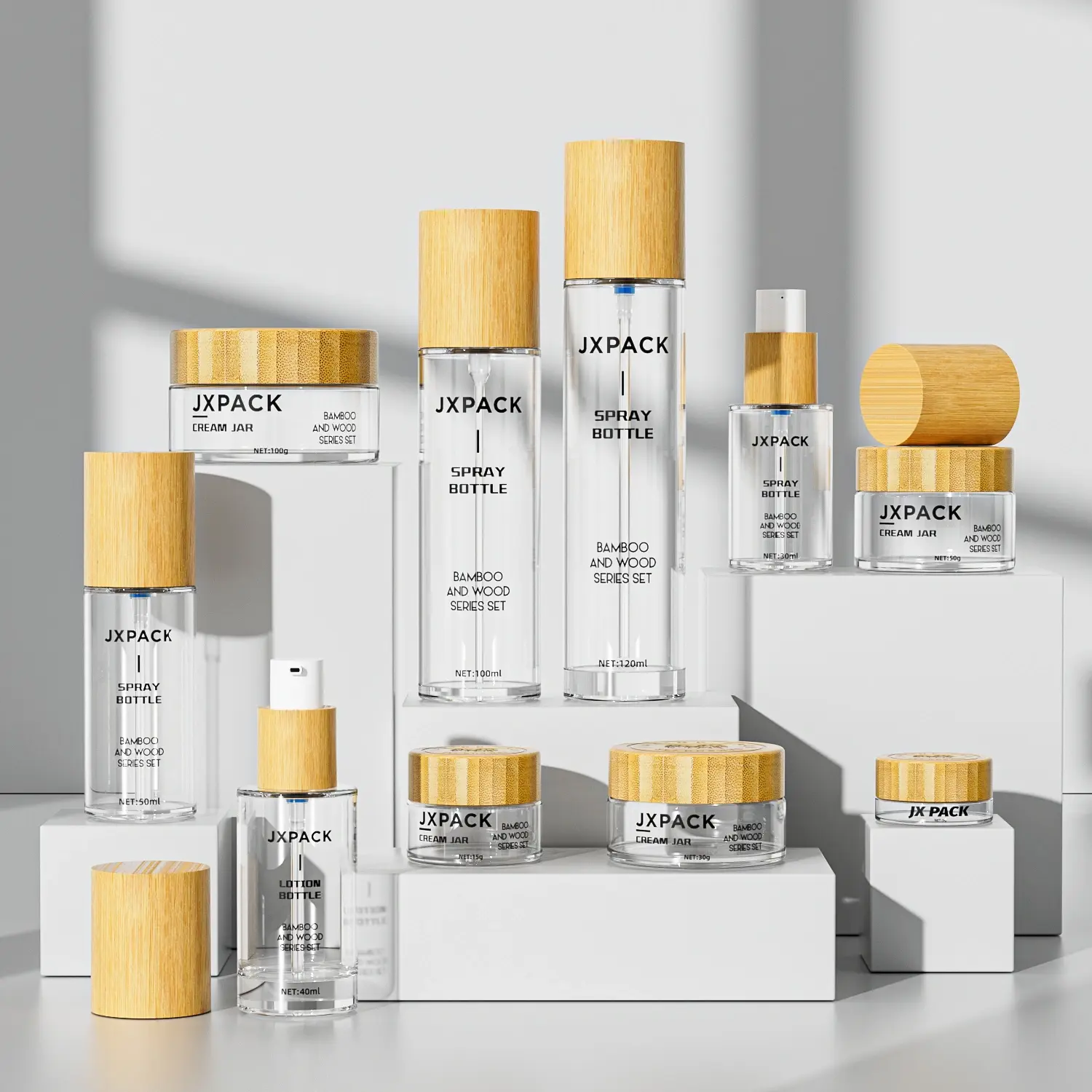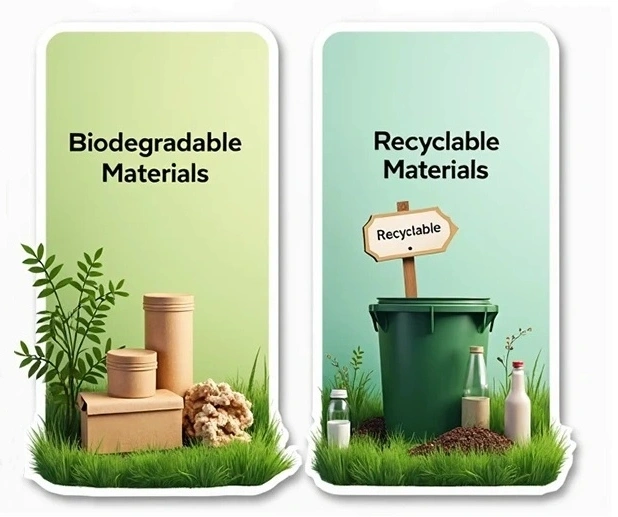The beauty industry is undergoing a transformative shift, with sustainability no longer just an option but an expectation. As consumers become increasingly eco-conscious, brands are seeking innovative ways to reduce their environmental footprint.
Two major contenders have emerged in the quest for greener packaging solutions: biodegradable and recyclable materials. But which one truly holds the key to a more sustainable future? Is it better to embrace materials that naturally decompose, returning to the earth, or to champion a circular economy that extends the life of packaging through continuous reuse? The answer is multifaceted, influenced by factors such as material composition, disposal infrastructure, and consumer behavior. Let’s explore the strengths and challenges of both approaches and uncover the path to truly sustainable beauty packaging.
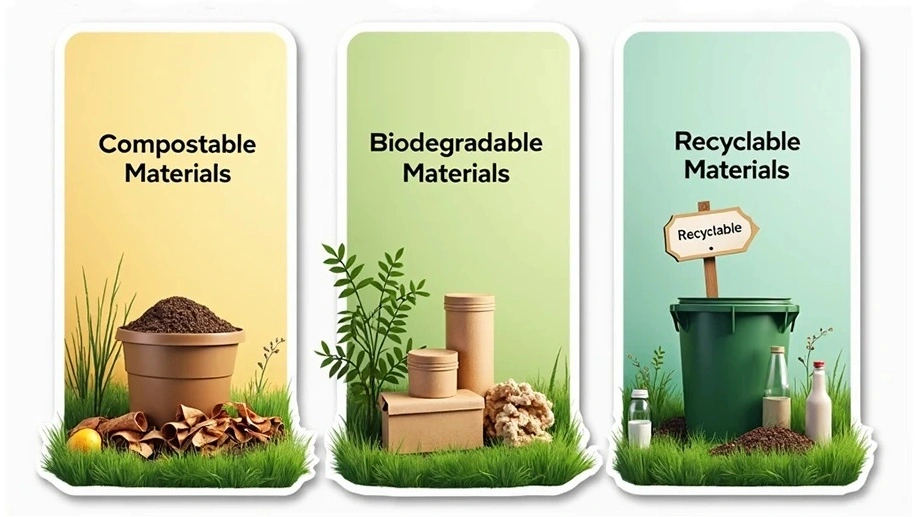
1. Biodegradable Cosmetic Packaging: Nature’s Solution
With the beauty industry shifting towards sustainability, biodegradable materials are gaining traction as a viable alternative to conventional plastic packaging. These materials decompose naturally under the right conditions, reducing environmental impact. However, understanding their properties, benefits, and challenges is crucial for choosing the right packaging solution.
What Are Biodegradable Materials?
Biodegradable materials are substances that can break down into natural elements—such as carbon dioxide, water, and biomass—through microbial activity. Unlike traditional plastics, which take hundreds of years to degrade, biodegradable materials decompose within a significantly shorter time, often within months or years.
Types of Biodegradable Materials Used in Cosmetic Packaging
1. Bioplastics (PLA & PHA)
Polylactic Acid (PLA): Derived from fermented plant starch (corn, sugarcane, or cassava), PLA is commonly used in cosmetic jars, tubes, and film wraps. It is compostable under industrial conditions but not always in home composting.
Polyhydroxyalkanoates (PHA): A natural polymer produced by bacteria, PHA is fully biodegradable in soil, freshwater, and marine environments. It is gaining popularity for beauty product packaging, especially for creams and lotions.
2. Molded Pulp & Paper-Based Packaging
Made from recycled paper, wood pulp, or agricultural waste, this material is widely used for outer cartons, compact cases, and inserts. It is lightweight, compostable, and can be customized for luxury or minimalist aesthetics.
3. Bamboo Packaging
Bamboo is a rapidly renewable resource used in cosmetic caps, compact cases, and makeup brushes. It is naturally antibacterial, biodegradable, and offers a premium, eco-friendly look.
4. Bagasse (Sugarcane Fiber) Packaging
A byproduct of sugarcane processing, bagasse is used to create biodegradable cosmetic containers and protective cartons. It is home-compostable and breaks down within 30–90 days.
5. Bio-Based Cellophane & Algae-Based Films
Unlike petroleum-based plastic wraps, bio-cellophane and algae-based films are biodegradable and used for outer product protection or sachets for sample products.
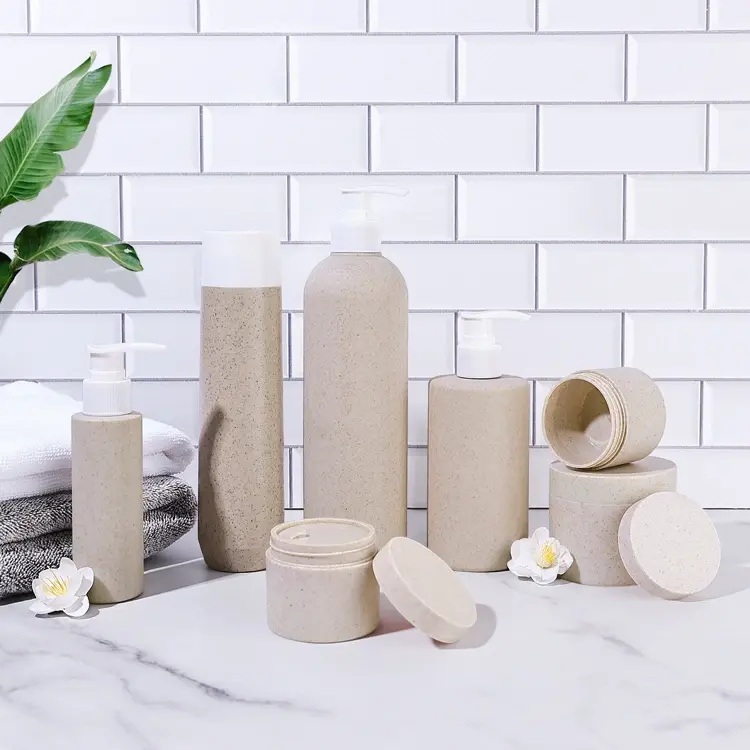
Benefits of Biodegradable Cosmetic Packaging
Reduces Plastic Waste
Biodegradable cosmetic packaging is designed to break down naturally, unlike traditional plastics that persist in landfills and oceans for centuries. This significantly reduces the environmental burden of plastic pollution, which is a critical issue in the beauty industry.
Sustainable Sourcing
Many biodegradable materials, such as bamboo, sugarcane, and plant fibers, are derived from renewable resources. These materials not only minimize reliance on fossil fuels but also promote resource efficiency and support a circular economy.
Eco-Friendly Disposal
Biodegradable packaging can decompose under specific conditions, either at home or in industrial composting facilities. This ensures that the packaging returns to the earth as non-toxic components, reducing landfill waste and contributing to soil enrichment.
Enhanced Brand Image
Consumers increasingly prioritize sustainability, and brands that adopt biodegradable packaging can differentiate themselves in the market. This commitment to eco-conscious practices enhances brand loyalty and appeals to environmentally aware customers.
Functional and Aesthetic Appeal
Biodegradable materials like PLA and bamboo offer durability, heat resistance, and a premium appearance, making them suitable for high-end cosmetic products. This allows brands to maintain quality while aligning with sustainability goals.
Regulatory Compliance
As governments impose stricter regulations on single-use plastics, biodegradable packaging helps brands stay compliant while demonstrating their commitment to environmental responsibility.
In summary, biodegradable cosmetic packaging offers a range of benefits, from reducing plastic waste and supporting sustainable sourcing to enhancing brand reputation and meeting regulatory standards. These advantages make it a key solution for brands aiming to align with the growing demand for eco-friendly products.
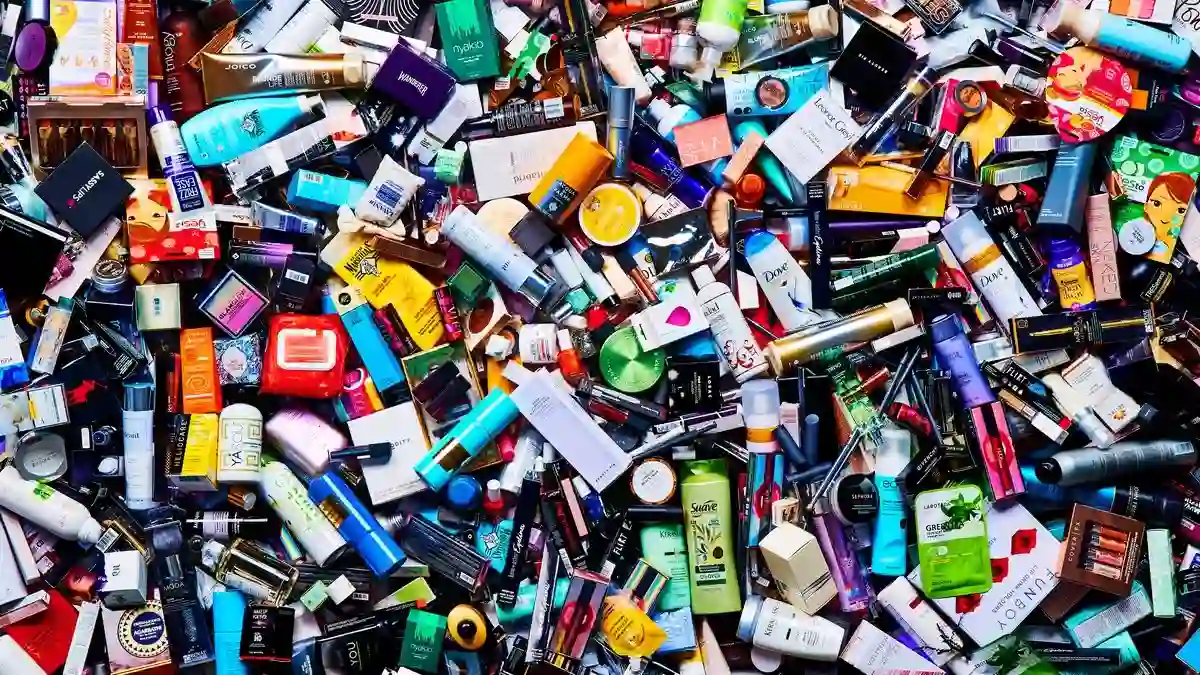
Challenges and Considerations
While biodegradable cosmetic packaging is gaining traction, several areas remain underexplored or require further innovation and research to maximize its potential.
Decomposition Efficiency
- Home vs. Industrial Composting: Many biodegradable materials require industrial composting facilities to break down effectively, which are not universally accessible. Research is needed to develop materials that decompose efficiently in home composting systems or natural environments.
- Timeframe: The decomposition rate of biodegradable materials varies widely. Optimizing this process to ensure timely breakdown without compromising product shelf life is a critical challenge.
Material Durability
- Moisture and Temperature Resistance: Biodegradable materials often lack the robustness of traditional plastics, making them susceptible to moisture and temperature changes. Innovations in material science are needed to enhance durability while maintaining biodegradability.
- Product Longevity: Ensuring that biodegradable packaging can protect products for extended periods without premature degradation is essential for consumer trust.
Cost and Scalability
- Production Costs: The manufacturing of biodegradable materials is often more expensive than traditional plastics due to limited material availability and specialized processes. Reducing costs through economies of scale and technological advancements is crucial for widespread adoption.
- Supply Chain Integration: Scaling up production and integrating biodegradable materials into existing supply chains without disrupting efficiency remains a significant hurdle.
Consumer Education
- Disposal Practices: Many consumers are unaware of the proper disposal methods for biodegradable packaging, such as separating compostable materials from recyclables. Effective education campaigns are needed to ensure these materials achieve their environmental potential.
- Misconceptions: Addressing misconceptions about biodegradability, such as the belief that all biodegradable materials decompose quickly in any environment, is essential for accurate consumer understanding.
Regulatory Standards
- Standardization: There is a lack of universal standards for biodegradable and compostable packaging, leading to inconsistencies in labeling and performance. Establishing clear regulations and certifications can help build consumer trust and industry accountability.
- Global Compliance: Navigating varying regulatory requirements across regions poses challenges for brands aiming to adopt biodegradable packaging globally.
Emerging Technologies
- Green Nanotechnology: Leveraging nanoscale materials to enhance the properties of biodegradable packaging, such as barrier protection and durability, is an underexplored area with significant potential.
- Biopolymers: Research into novel biopolymers derived from natural sources like algae or bacteria could yield materials with superior biodegradability and functional properties.
Environmental Impact
- Life Cycle Analysis: Comprehensive studies on the environmental impact of biodegradable materials, from production to disposal, are needed to ensure they are truly sustainable compared to alternatives.
- Microplastic Concerns: Some biodegradable materials may still break down into microplastics under certain conditions. Research is required to eliminate this risk entirely.
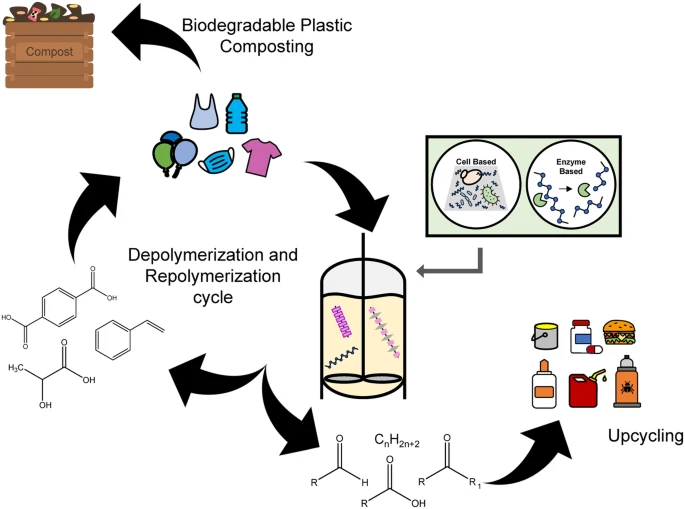
2. Recyclable Cosmetic Packaging: The Circular Economy Approach
Recyclable packaging is becoming essential in the beauty industry’s shift toward sustainability. Materials like glass, aluminum, and recyclable plastics help reduce waste and support a circular economy. However, choosing the right packaging requires considering material properties, recycling systems, and consumer behavior to ensure sustainability without compromising functionality or brand appeal.
What Are Recyclable Materials?
Recyclable materials are substances that can be collected, processed, and reused to create new products, reducing waste and environmental impact. These materials play a crucial role in sustainable packaging, particularly in the cosmetics industry.
Types of Recyclable Materials Used in Cosmetic Packaging
1. Glass Packaging
Glass is a sustainable choice for cosmetic packaging due to its 100% recyclability and reusability. It is commonly used for luxury products, offering a premium look and strong barrier protection. Clear glass is easiest to recycle, while colored or frosted glass may face restrictions. Despite this, glass remains a preferred option for brands seeking both elegance and sustainability.
2. Plastics Packaging (PET, HDPE, PP)
PET (Polyethylene Terephthalate) is a durable and versatile material widely used in cosmetic packaging. Clear PET is highly recyclable and easily repurposed, while colored PET is harder to process due to additives. To enhance recyclability and sustainability, brands are encouraged to use clear PET over colored variants.
HDPE (High-Density Polyethylene) is a durable and chemically resistant material used in cosmetic packaging for skincare tubes, cream jars, and body wash bottles. White or natural HDPE is preferred for recycling, while colored HDPE is often downcycled due to pigment complications. Brands are prioritizing natural HDPE to enhance recyclability and sustainability.
PP (Polypropylene) is commonly used for caps, closures, mascara tubes, and airless pumps due to its durability and chemical resistance. However, it is less frequently recycled due to limited infrastructure and demand. Efforts to improve PP recyclability and integrate post-consumer recycled (PCR) PP are increasing, making it a more sustainable choice.
3. AluminumPackaging
Aluminum is a lightweight, rust-resistant, and infinitely recyclable material used in deodorant sticks, lip balm tubes, and cosmetic tins. It provides excellent barrier protection, but efficient recycling requires proper sorting and easy separation of plastic components. Prioritizing minimalist designs and consumer education enhances recyclability, making aluminum a key material in sustainable cosmetic packaging.
4. Paper & CardboardPackaging
Paper and cardboard are widely used for outer packaging, refill packs, and eco-friendly compacts due to their renewable and recyclable nature. To maximize recyclability, they should be free from plastic coatings and excessive ink. While innovations like paper bottles are emerging, challenges such as moisture resistance and maintaining a premium feel persist. Sustainable coatings and innovative designs can help brands optimize paper-based packaging for eco-friendly solutions.

Benefits of Recyclable Cosmetic Packaging
Reduces Plastic Waste
Recyclable packaging helps divert waste from landfills and oceans, addressing the global issue of plastic pollution. By using materials like glass, aluminum, and PCR (Post-Consumer Recycled) plastics, brands can significantly minimize their environmental footprint.
Lowers Carbon Footprint
Recycling materials like glass and aluminum requires less energy compared to producing virgin materials, reducing greenhouse gas emissions. This aligns with global efforts to combat climate change and promotes a circular economy.
Enhances Brand Image
Consumers increasingly prefer brands that prioritize sustainability. Adopting recyclable packaging demonstrates a commitment to environmental responsibility, fostering brand loyalty and attracting eco-conscious customers.
Cost Efficiency
Recyclable materials, especially lightweight options like aluminum and paper, reduce shipping and storage costs. Additionally, using PCR plastics can lower production expenses by repurposing existing materials.
Compliance with Regulations
As governments impose stricter regulations on single-use plastics, recyclable packaging ensures brands remain compliant while positioning them as industry leaders in sustainability.
Consumer Appeal
Recyclable packaging resonates with environmentally aware consumers, who are willing to pay a premium for products that align with their values. This expands the brand’s customer base and strengthens its market presence.
Promotes Circular Economy
By designing packaging that can be reused or recycled, brands contribute to a circular economy, where materials are continuously repurposed, reducing the need for virgin resources.
Conclusion: Recyclable cosmetic packaging not only reduces environmental impact but also enhances brand reputation, cuts costs, and aligns with consumer preferences for sustainability. As the beauty industry evolves, recyclable materials will play a pivotal role in shaping a more eco-friendly future.
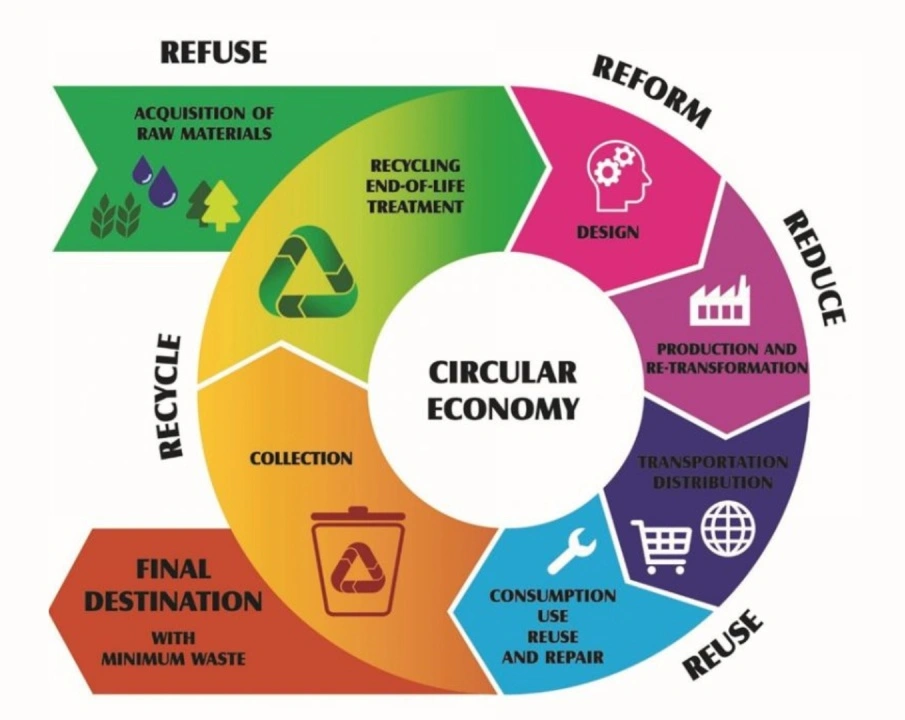
Challenges and Considerations
Recyclability and Material Complexity
• Multi-Material Packaging: Many cosmetic products use multi-material packaging (e.g., plastic with metal or paper), which complicates recycling due to the need for separation and processing of different materials.
• Residue Contamination: Used packaging often retains product residue, requiring intensive cleaning before recycling, which can be resource-intensive.
• Colored and Dyed Materials: Colored plastics and dyes in packaging make sorting and recycling more challenging, reducing the efficiency of recycling processes.
Durability and Functionality
• Paper and Cardboard: While recyclable, paper-based packaging is less durable and moisture-resistant compared to plastic, making it prone to damage during shipping and handling.
• Plastic Alternatives: Biodegradable plastics like PLA may lack the durability and heat resistance of traditional plastics, limiting their use in certain cosmetic products.
Cost and Scalability
• Higher Costs: Sustainable materials like biodegradable plastics or recycled paper can be more expensive to produce and source, impacting overall packaging costs.
• Production Speed: Some eco-friendly materials require specialized manufacturing processes, which can slow down production and increase costs.
Consumer Behavior and Education
• Recycling Infrastructure: Inadequate recycling infrastructure in many regions limits the effectiveness of recyclable packaging, as consumers may not have access to proper disposal options.
• Consumer Awareness: Many consumers are unaware of how to properly dispose of recyclable or biodegradable packaging, leading to contamination or improper disposal.
Regulatory and Industry Challenges
• Regulatory Compliance: Emerging regulations, such as the EU’s “Packaging and Packaging Waste Regulation” (PPWR), require brands to ensure their packaging is recyclable by 2030, posing a significant challenge for complex or multi-material designs.
• Market Demand: The demand for recycled materials can fluctuate, impacting the feasibility of using recycled content in packaging.
Environmental Impact
• Carbon Footprint: While paper and cardboard are more sustainable than plastic, their production and transportation still contribute to carbon emissions.
• Landfill Waste: Despite being recyclable, a significant portion of packaging still ends up in landfills due to improper disposal or lack of recycling facilities.
Conclusion: While recyclable and biodegradable packaging offer significant environmental benefits, challenges like material complexity, durability, cost, and consumer behavior must be addressed. Innovations in design, material science, and recycling infrastructure, along with consumer education, are critical to overcoming these hurdles and achieving truly sustainable cosmetic packaging.

3. Combining Biodegradable and Recyclable Packaging for a Greener Future
Hybrid Approach: A balanced packaging strategy combines recyclable materials, such as glass and aluminum, for long-term use with biodegradable options, like compostable packaging for single-use items. This approach ensures that each material is used where it is most effective, maximizing functionality while minimizing environmental impact.
Circular Economy: By designing packaging for recyclability or compostability and integrating recycled content into new products, businesses can reduce waste and resource consumption. This closed-loop system supports material reuse, lowers dependence on virgin resources, and promotes long-term sustainability.
Consumer Education: Proper disposal is essential to the success of both biodegradable and recyclable packaging. Brands should clearly label products with disposal instructions and educate consumers on waste separation to prevent contamination. Raising awareness ensures that sustainable packaging solutions fulfill their environmental potential.
4. Conclusion
The beauty industry is increasingly adopting biodegradable and recyclable packaging to address environmental concerns. Biodegradable materials like PLA, PHA, and bamboo decompose naturally, reducing plastic waste and supporting a circular economy. However, challenges such as composting infrastructure, durability, and higher costs remain significant barriers. On the other hand, recyclable packaging—using materials like glass, aluminum, and PET plastics—extends material life and reduces environmental impact. Yet, issues like residue contamination and multi-material complexity hinder its effectiveness.
A hybrid approach, combining biodegradable materials for single-use items and recyclable options for long-term packaging, offers a balanced and sustainable solution. This strategy leverages the strengths of each material while minimizing their weaknesses. Additionally, consumer education on proper disposal and improved recycling infrastructure are essential to maximize the benefits of both methods. By integrating innovative materials, responsible design, and clear communication, the beauty industry can significantly reduce its ecological footprint and contribute to a greener future.
5. Final Note
Othilapak, a manufacturer committed to sustainable packaging, can take several effective steps to strengthen its environmental practices. First, we can use recyclable and biodegradable materials, incorporate post-consumer recycled (PCR) content, and explore options such as PLA, PHA, and sugarcane bioresin for single-use items. Optimizing packaging design through a minimalist and multifunctional approach can reduce material use and waste. In addition, we can adopt lean manufacturing principles to minimize waste and increase energy efficiency.
To further achieve its sustainability goals, we work with suppliers and innovators to source environmentally friendly materials and learn from industry leaders. Othilapak should also innovate with emerging technologies, such as pioneering reusable packaging as well as recyclable materials, and set clear sustainability goals. By implementing these strategies, it can significantly reduce its environmental footprint, meet consumer demand for environmentally friendly solutions, and lead the way in sustainable packaging innovation.
